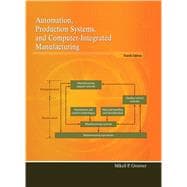Automation, Production Systems, and Computer-Integrated Manufacturing is appropriate for advanced undergraduate/ graduate-level courses in Automation, Production Systems, and Computer-Integrated Manufacturing. The book should also be useful for practicing engineers and managers who wish to learn about automation and production systems technologies in modern manufacturing.
This exploration of the technical and engineering aspects of automated production systems provides the most advanced, comprehensive, and balanced coverage of the subject of any text on the market. It covers all the major cutting-edge technologies of production automation and material handling, and how these technologies are used to construct modern manufacturing systems.
Teaching and Learning Experience
This book will provide a better teaching and learning experience—for you and your students. It will help:
- Provide Balanced Coverage of Automated Production Systems: A quantitative approach provides numerous equations and example problems for instructors who want to include analytical and quantitative material in their courses.
- Support Learning: End-of-chapter problems, review questions, and problem exercises give students plenty of opportunities to put theory into action.
- Keep Your Course Current: This edition provides up-to-date coverage of production systems, how they are sometimes automated and computerized, and how they can be mathematically analyzed to obtain performance metrics.








